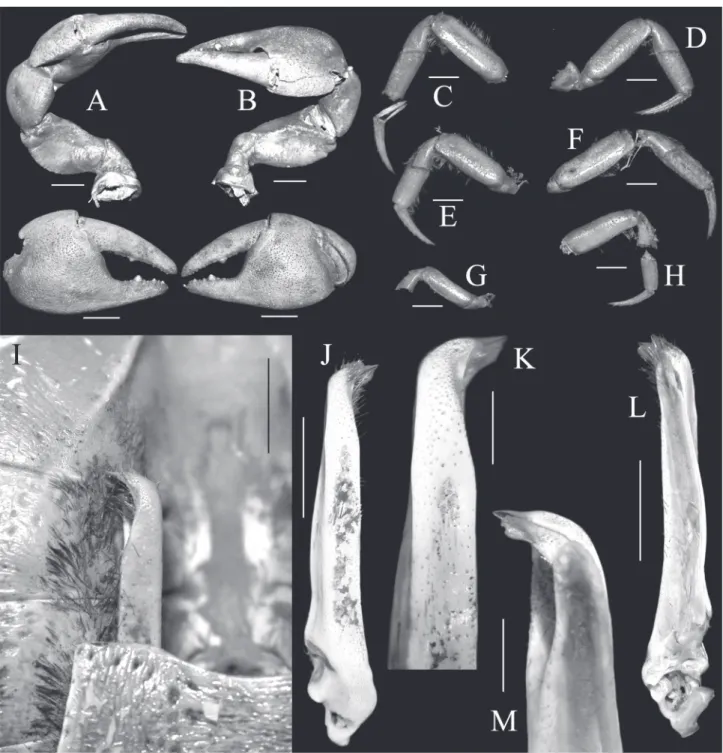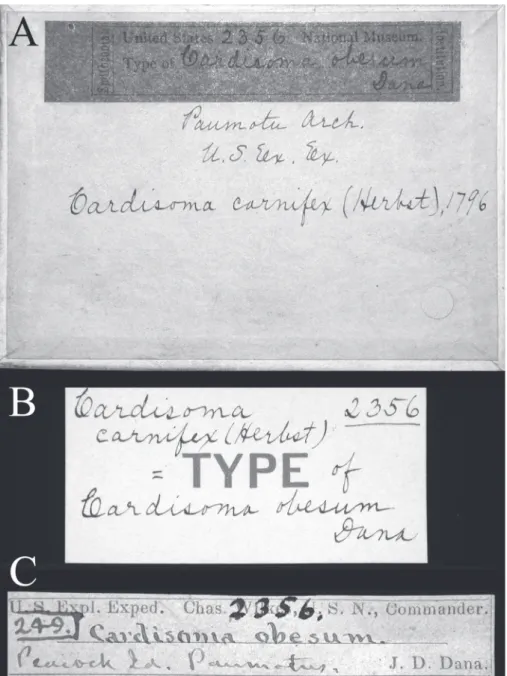Nauplius
T
HEJ
OURNAL OFT
HEB
RAZILIANC
RUSTACEANS
OCIETYe-ISSN 2358-2936
www.scielo.br/nau www.crustacea.org.br
On the extant type material of
Cardisoma
hirtipes
Dana, 1851,
and
Cardisoma obesum
Dana, 1851
(Crustacea: Brachyura: Gecarcinidae)
Peter K. L. Ng
11 Lee Kong Chian Natural History Museum, National University of Singapore, Kent
Ridge, Singapore 119260, Republic of Singapore.
ZOOBANK htt p://zoobank.org/urn:lsid:zoobank.org:pub:3BCAD6EA-E72F-4889-8941-1ECD60E74E51
A
BSTRACTTwo boxes in the U.S. National Museum of Natural History, Smithsonian
Institution, were found to contain the dried type material of the land
crabs
Cardisoma
hirtipes
Dana, 1851, and
Cardisoma obesum
Dana, 1851
(Gecarcinidae). Th e types of the common Pacifi c land crab,
C.
hirtipes
were
believed to have been lost and a neotype had been designated in earlier
revisions.
Cardisoma obesum
Dana, 1851 is currently regarded as a junior
subjective synonym of
Cardisoma carnifex
(Herbst, 1796).
K
EY WORDSLand crab, type specimens, Dana material,
Cardisoma
, taxonomy.
Recently, two specimens of gecarcinid crabs were found in the dried
collection of the U.S. National Museum of Natural History (USNM),
Smithsonian Institution, Washington D.C., which have been forgott en by
taxonomists working on this family. Th e specimens were identifi ed as the
types of
Cardisoma
hirtipes
Dana, 1851, and
Cardisoma obesum
Dana, 1851.
Th eir features and proportions agree well with the measurements given by
Dana (1851) in his original description; and together with the labels, leave
no doubt to their identities.
S
HORTC
OMMUNICATIONNauplius
OCIETY
Nauplius
OCIETY
by the Brazilian Crustacean Society
in memoriam
of
Michael Türkay
for his
outstanding contribution to Carcinology
CORRESPONDING AUTHOR
Peter K. L. Ng
peterng@nus.edu.sg
SUBMITTED 13 February 2017
ACCEPTED 12 April 2017
PUBLISHED 22 June 2017
Guest Editor
Célio Magalhães
T
AXONOMYFamily Gecarcinidae MacLeay, 1838
Genus
Discoplax
A. Milne-Edwards, 1867
Discoplax hirtipes
(Dana, 1851)
(
Figs. 1–3
)
Cardisoma hirtipes
Dana, 1851: 253 (for complete
synonymy, see Ng and Shih, 2014: 112).
Type material
. Lectotype male (58.2 × 47.4 mm)
(USNM 2356), “Viti” (= Fiji), ca. 17
º
48’S 178
º
00’E,
coll. U.S. Exploring Expedition.
Remarks
.
Cardisoma hirtipes
was described by Dana
(1851: 253) from “Viti” (= Fiji), who listed only one
specimen (sex not specified) measuring 28 × 22.5
lines (see also Dana, 1852: 376). Dana (1852: 377)
redescribed the species, noting that the specimen was
a male from the “Feejee Islands”. This was apparently
the same specimen figured by him later (Dana, 1855:
pl. 24, fig. 2). The line was an English unit of measure
that has been variously equivalent to
1⁄
10
,
1⁄
12
,
1⁄
16
or
1⁄
40
of an inch (= 25.4 mm). In the older literature,
English-speaking biologists usually equated a line with
1⁄
12
of
an inch (or 2.1 mm). That would put the dimensions
of Dana’s male specimen at 58.8 × 47.3 mm. Evans
(1967) had listed a type specimen of the Pacific land
crab
C.
hirtipes
(Gecarcinidae) in the Natural History
Museum, London (see also Türkay, 1974). Ng and
Clark (2014) examined the specimen and argued
that this was actually not a type, belonging to another
species,
Cardisoma carnifex
(Herbst, 1796), instead.
They commented that since there were no extant types
of the species, the neotype male specimen from Fiji
designated by Ng and Davie (2012) therefore remained
the valid type of
C.
hirtipes
.
The present specimen (USNM 2356) is a male
58.2 × 47.4 mm and agrees well with the size given
by Dana (1851): 58.8 × 47.3 mm. There is no doubt
this is the specimen examined and figured by Dana
(1851; 1852; 1855). Although Dana (1851; 1852;
1855) mentioned and figured only this one specimen,
he did not state it was the holotype or make it clear he
only had one specimen (see Ng and Clark, 2014). As
such, it is preferable to designate USNM 2356 as the
lectotype of
C.
hirtipes
.
The present lectotype is interesting as the left male
first gonopod (G1) had been detached (
Figs. 2D, 3I
).
The G1 was subsequently rehydrated and was shelved
in the wet collections of the USNM (
Fig. 3J–M
). Who
did this is not known as neither the box with the dried
body or the bottle with the G1 had any labels to this
effect.
Interestingly, Türkay (1974: 233) listed among
his material examined for
D. hirtipes
(as a
Cardisoma
Latreille in Latreille, Le Peletier, Serville & Guérin,
1828) as follows: “Südsee, Viti (1 Go/1 des Holotypus
von
Cardisoma hirtipes
DANA 1851)”. He did not
indicate where the specimen was from and which
museum it was kept in, and was not discussed anywhere
Figure 3. Cardisoma hirtipes Dana, 1851, lectotype male (58.2 × 47.4 mm) (USNM 2356). A, dorsal view of left cheliped; B, dorsal view of right cheliped; C, outer view of right chela; D, outer view of left chela; C, left first ambulatory leg; D, right first ambulatory leg; E, left second ambulatory leg; F, right second ambulatory leg; G, left fourth ambulatory leg; H, right third ambulatory leg; I, sternoabdominal cavity with intact right G1; J, ventral view of left G1; K, distal half of left G1, ventral view (denuded); L, dorsal view of left G1; M, distal half of left G1, dorsal view (denuded). Scale bars: A–H = 10.0 mm; I, J, L = 5.0 mm; K, M = 2.0 mm.
else in his paper. Ng and Clark (2014: 596) was advised
by the late Michael Türkay that he had actually not
examined the holotype of the species and the type
he had referred to was the specimen recorded by
Evans (1967). Could the detached G1 in USNM be
the one he had actually examined instead and then
inadvertently forgot in the ensuing years?
Cardisoma carnifex
(Herbst, 1796)
(
Figs. 4, 5
)
Cancer carnifex
Herbst, 1796: 163, pl. 41, fig. 1 (for
complete synonymy, see Türkay, 1974: 224).
Cardisoma obesum
Dana, 1851: 252.
Type material
. 1 carapace (90.6 × 70.0 mm) (USNM
2356), Peacock Island, Tuamotu, 14°30’S 146°18’W,
coll. U.S. Exploring Expedition.
Remarks
.
Cardisoma obesum
was described by Dana
(1851: 252–253) from “Paumotu” (= Tuamotu) in
French Polynesia, and he listed one specimen (sex not
specified) measuring 3.67 by 3 inches (93.2 × 76.2
mm). Dana (1852: 376) redescribed the species and
figured the carapace, noting that it was from Peacock
Island in the Paumotu Archipelago, and that the “... only
specimen of this species saved from among the many
collected, is a carapax.” The front of the carapace was
figured in Dana (1855: pl. 24, fig. 1).
Cardisoma obesum
is currently regarded as a junior subjective synonym
of
C. carnifex
(see Türkay, 1974). The whereabouts of
the type of
C. obesum
, was to date not known.
The present specimen (USNM 2356) measures
90.6 × 70.0 mm and the measurements are slightly
smaller from that given by Dana (1851) but this can
Figure 5. Cardisoma obesum Dana, 1851, lectotype male (90.6 × 70.0 mm) (USNM 2356). A, dorsal view of carapace; B, frontal view of cephalothorax. Scale bars = 10.0 mm.
easily be explained by the fact that all that is left of the
specimen is the carapace and the left side is broken
and in poor condition. As thus, there is doubt this is
in fact the holotype specimen of
C. obesum
.
A
CKNOWLEDGEMENTSThe author is grateful to Rafael Lemaitre and
Karen Reed (USNM) for helping him find the
dried specimens in question. The visit to USNM
was facilitated by a travel grant from the National
University of Singapore. This note is dedicated to an
old friend, Michael Türkay, and the author of so many
important papers on Brachyura, including especially
the Gecarcinidae, which he always loved.
R
EFERENCESAnonymous. 1851. Conspectus Crustaceorum, &c.; Crustacea of the Exploring Expedition; by James D. Dana. —Crustacea Grapsoidea, (Proceedings of the Academy of Natural Sciences of Philadelphia, 1851: 247). In: Scientific Intelligence. II Botany and Zoology. American Journal of Science and Arts, ser. 2, 12 (36) [November]: 439.
Anonymous. 1852. Books added to the Library up to December 31st [1851]. Proceedings of the Boston Society of Natural History, 4: 171–174.
Dana, J.D. 1851. Conspectus Crustaceorum quae in Orbis
Terrarum circumnavigatione, Carolo Wilkes e Classe Reipublicae Foederatae Duce. Crustacea Grapsoidea, (Cyclometopa, Edwardsii). Proceedings of the Academy of Natural Sciences of Philadelphia, 5(10): 247–254. [Published before 30 November 1851 (Anonymous, 1851: 439), and 31 December 1851 (Anonymous, 1852: 173); also issued as a separate with the same title and pagination 1–8]
Dana, J.D. 1852. Crustacea. Part I. In: United States Exploring Expedition, During the Years 1838, 1839, 1840, 1841, 1842, Under the Command of Charles Wilkes, U.S.N., 13(1): i–viii, 1–685. Philadelphia, C. Sherman.
Dana, J.D. 1855. Crustacea: Atlas. In: United States Exploring Expedition during the years 1838, 1839, 1840, 1841, 1842, under the Command of Charles Wilkes, U.S.N., 14: 1–27, pls. 1–96.
Evans, A.C. 1967. Syntypes of Decapoda described by William Stimpson and James Dana in the collections of the British Museum (Natural History). Journal of Natural History, 1: 399–411.
Herbst, J.F.W. 1782–1804. Versuch einer Naturgeschichte der Krabben und Krebse nebst einer systematischen Beschreibung ihrer verschieden Arten. Gottlieb August Lange, Berlin & Stralsund. Volumes 1–3: 1–274 + 1–226 +1–66 + 1–46, 1–54 + 1–49, Pls. 1–62. [Vol. 1, Part 1 (Pp. 1–86, Pl. 1): 1782; Vol. 1, Parts 2–5 (Pp. 87–182, Pls. 2–9): 1783; Vol. 1, Part 6 (Pp. 183–206, Pls. 10–13): 1785; Vol. 1, Part 7 (Pp. 207–238, Pls. 14–17): 1788; Vol. 1, Part 8 (Pp. 239–274, Pls. 18–21): 1790; Vol. 2, Part 1 (Pp. 1–48, Pls. 22–25): 1791; Vol. 2, Part 2 (Pp. 49–78, Pls. 26–29): 1792; Vol. 2, Part 3 (Pp. 79–98, Pls. 30–33): 1793; Vol. 2, Part 4 (Pp. 99–146, Pls. 34–36): 1793; Vol. 2, Part 5 (Pp. 147–162, Pls. 37–40): 1794; Vol. 2, Parts 6–end (Pp. 163–226, Pls. 41–46): 1796; Vol. 3, Part 1 (1–66, Pls. 47–50): 1799; Vol. 3, Part 2 (Pp. 1–46, Pls. 51–54): 1801; Vol. 3, Part 3 (Pp. 1–54, Pls. 55–58): 1803; Vol. 3, Part 4 (Pp. 1–49, Pls. 59–62): 1804.] [For dates of publication, see Rathbun, 1897: 157; Sherborn, 1902: xxix]
published under the Authority of the Lords Commissioners of Her Majesty’s Treasury, Invertebratae. IV [1849]. pp. 53–71, pls. 2, 3. London, Smith, Elder & Co.
Milne-Edwards, A. 1867. Description de quelques espèces
nouvelles de Crustacés Brachyoures. Annales de la Société Entomogique de France, (4)7: 263–288.
Ng, P.K.L. and Clark, P.F. 2014. The type of the land crab Cardisoma hirtipes Dana, 1851 (Crustacea: Brachyura: Gecarcinidae). Zootaxa, 3860: 596–599.
Ng, P.K.L. and Davie, P.J.F. 2012. The Blue Crab of Christmas Island, Discoplaxceleste, new species (Crustacea: Decapoda: Brachyura: Gecarcinidae). RafflesBulletin of Zoology, 60: 89–100.
Ng, P.K.L. and Guinot, D. 2001. On the land crabs of the genus Discoplax A. Milne-Edwards, 1867 (Crustacea: Decapoda: Brachyura: Gecarcinidae), with description of a new cavernicolous species from the Philippines. Raffles Bulletin of Zoology, 49: 311– 338.
Ng, P.K.L. and Shih, H.-T. 2014. The systematics of the land crabs of the Discoplaxhirtipes (Dana, 1851) species-group (Crustacea: Decapoda: Brachyura: Gecarcinidae), with description of a new species from the eastern Indian Ocean. In: H.H. Tan, M. Orchard, P.J.F. Davie and P.K.L. Ng (eds), Christmas Island and Cocos (Keeling) Islands: Biodiversity and Management Challenges. Raffles Bulletin of Zoology, Supplement 30: 109–135.
Rathbun, M.J. 1897. A revision of the nomenclature of the Brachyura. Proceedings of the Biological Society of Washington, 11: 153–167.
Sherborn, C.D. 1902. Index animalium sive index nominum
quae ab A.D. MDCCLVIII generibus et speciebus animalium imposita sunt societatibus eruditorum adiuvantibus. Sectio prima a kalendis Ianuariis, MDCCLVIII usque ad finem Decembris, MDCCC. Cambridge, Cambridge University Press.
Türkay, M. 1974. Die Gecarcinidae Asiens und Ozeaniens




